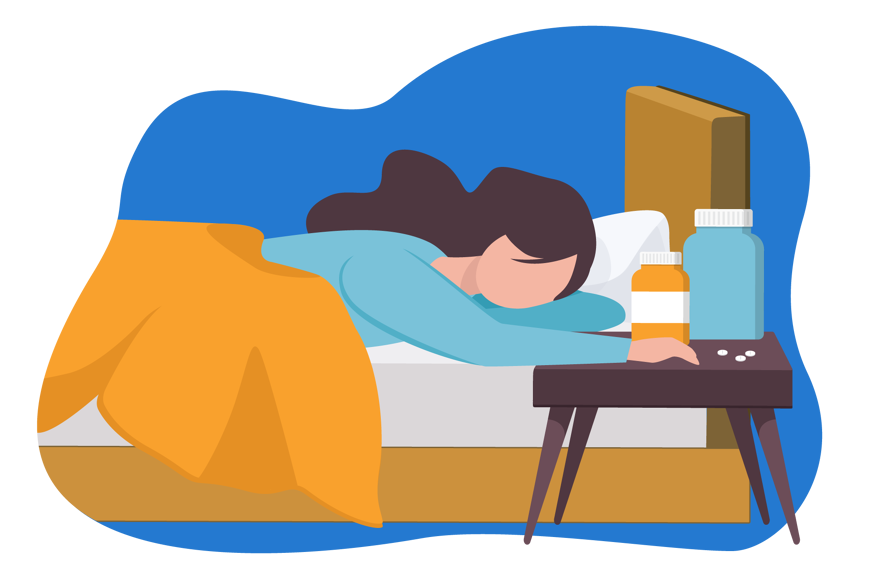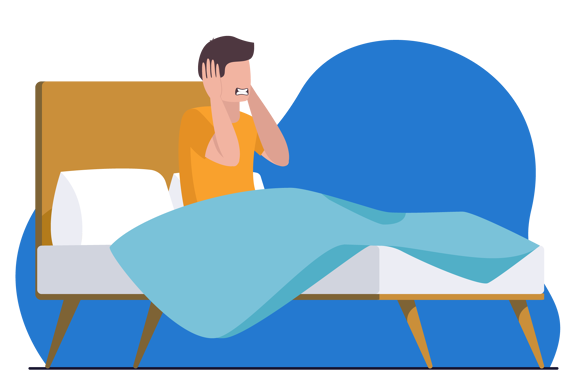How to sleep with broken ribs
Rib injuries can be quite uncomfortable and interfere with good sleep, so you're likely asking yourself how to sleep with a broken rib.
But a few simple tips and tricks can help make your sleep more pleasant and restorative.
Let's take a closer look.
Limit your movements while sleeping
When we sleep, we naturally move and change positions.
However, excess movement can exacerbate pain and hinder the healing process.

In the initial days following your injury, it's crucial to minimise movements like twisting or turning.
The best way to counteract this is by arranging your pillows in a way that supports your upper body and restricts unnecessary movement.
It may seem more intuitive to wrap your ribs to limit movements, but this should be avoided.
Wrapping your ribs could potentially increase your risk of complications, like a collapsed lung [1] or lung infections.
Use over-the-counter pain relievers
Over-the-counter pain meds are an effective way to tackle pain from rib injuries.

Non-prescription painkillers, such as ibuprofen [2], acetaminophen [3], or paracetamol [4], can help reduce inflammation and alleviate pain, making it easier to rest comfortably.
However, you should always follow the recommended dosage instructions and consult your doctor before starting any new pain medication. 📝
Practise deep breathing exercises
Taking shallow breaths while sustaining a rib injury might seem like a good idea, but deep breathing exercises actually help alleviate pain and encourage proper lung function and circulation. 🫁
To perform these deep breathing exercises, find a comfortable position, breathe in slowly through your nose, and allow your chest and abdomen to expand.
Hold your breath for a few seconds before slowly exhaling through the mouth.
Repeating this process several times will help you relax and ease your discomfort.

It's important to be gentle with your body during these exercises and always listen to its signals.
Stop immediately if you feel more pain, and consult your healthcare professional for guidance.
Use a heating pad or ice pack
Using a heating pad or ice pack can be an effective way to manage pain and discomfort.
Heating pads can help relax tense muscles around the injured area, reducing pain and promoting better sleep. 🌡️
While using the heating pad, make sure that it isn’t too hot to avoid burns.
You should also only use it for short periods to prevent overheating.


Ice packs are also an effective way to reduce inflammation and numb pain, especially in the early stages of an injury. 🧊
When using an ice pack, wrap it in a thin towel to protect your skin from frostbite.
You should limit ice pack application to 20-minute intervals for the best results.
Support your injured side with pillows
By providing adequate support, you can minimise the pressure on your ribs, allowing them to heal more effectively.
One way to do this is to use extra pillows to prop up the affected ribs.
This can help relieve discomfort and allow you to maintain a more comfortable sleeping position.
We recommend using a body pillow, large V pillow, or special rib support pillows that mould to your body and provide targeted support to the injured area.

We've listed a few of our favourite support pillows below, which can help you get a better night's sleep.
Best sleeping positions for broken ribs
Adjusting your sleeping position can reduce pressure on the injured area and minimise pain during the night.
Of course, when sleeping with a rib injury, avoid lying directly on the injured side - doing so will put more pressure on the broken bones and cause further pain.
Instead, try sleeping on your back with a pillow under your knees.
This position helps to maintain the natural curvature of your spine and reduces strain on your rib cage.

Another option is to sleep in a slightly elevated position, propping yourself up with a wedge pillow or sleeping on a recliner.
This angle can help reduce discomfort by taking weight off your ribcage and making breathing easier.
If you're adamant about sleeping on your side, you should lie on your uninjured side with a pillow between your knees - this will help align your spine and support your injured ribs.
You may need to experiment with different combinations of pillows and supports to find the most comfortable position for your particular injury.
The pillows below might prove particularly helpful for sleeping with a rib injury:
How to get out of bed with broken ribs
Getting in and out of bed with broken ribs can be difficult, but it can be done safely if you're careful and gentle.
Getting into bed with broken ribs:
- To get into bed, sit on the edge of your mattress and hold your injured side away from the bed.
- Slowly drop onto your side and gently swing your legs onto the mattress, using your arm for support.
- Roll onto your back or into your preferred sleeping position, moving carefully and avoiding putting pressure on the injured area.
Reverse this process when getting up.
Getting out of bed with broken ribs:
- Turn onto your side.
- Gently swing your legs out of bed.
- Move into a sitting position using your arms for support.
Remember to be gentle with yourself.
This is a time to rest and recover, and you really want to focus on your well-being.
Lighting a relaxation candle or using a pillow mist may also help you relax and sleep better:
What are the most common rib injuries?
Understanding your rib injury is essential for finding ways to sleep comfortably and safely.
We'll break down some common rib injuries below:
- Broken ribs: This means the bone has been completely severed.
- Fractured/cracked ribs: This injury includes partial breaks or hairline cracks.
- Bruised ribs/intercostal muscle strains: This injury includes damage to the surrounding muscles and tissue, without the actual bone being broken.
But perhaps you're not sure if you even have a rib injury. 🤔
The infographic below lists a few of the most common symptoms:

Symptoms of rib injuries include severe pain, swelling, and difficulty breathing, which can significantly affect your ability to sleep well.
Swelling and inflammation around the injured area can worsen matters by causing discomfort and pressure on the surrounding structures.
When should you seek medical attention?
Recognising when you should seek medical attention or further broken rib treatment is crucial. 👩🏼⚕️
If you experience any of the following symptoms, it's a good idea to consult your doctor:
- Persistent or worsening pain, including chest pain, despite following your prescribed treatment plan.
- Increased difficulty in breathing or shortness of breath that doesn't improve with rest or changes in position.
- Signs of infection, including redness, warmth, or pus around the injury site.
- A sudden increase in swelling or the appearance of new bruising.
- The development of a fever or chills, either of which could indicate an underlying infection.
Additionally, if you're unsure whether you're healing as expected, it's a good idea to contact your healthcare provider for a follow-up so you can discuss your broken rib injury recovery time.
It's always best to err on the side of caution and consult a professional - they can offer tailored advice and ensure you're on the right track to recovery.
So, what is the best way to sleep with broken ribs?
Dealing with rib injuries can be an uncomfortable experience, especially when trying to get a good night's sleep. 😴
Implementing some of the tips and strategies we've discussed above can greatly enhance your comfort levels and ensure safer, more restful sleep.
Most importantly, adjust your sleeping position and use supportive pillows to alleviate discomfort.
Also, remember the importance of managing pain, practising deep breathing exercises, and being cautious when getting in and out of bed.
With patience and care, you can successfully navigate your healing process and enjoy restorative sleep, even with broken ribs.























Alternatively, message us directly via the Contact Us page.